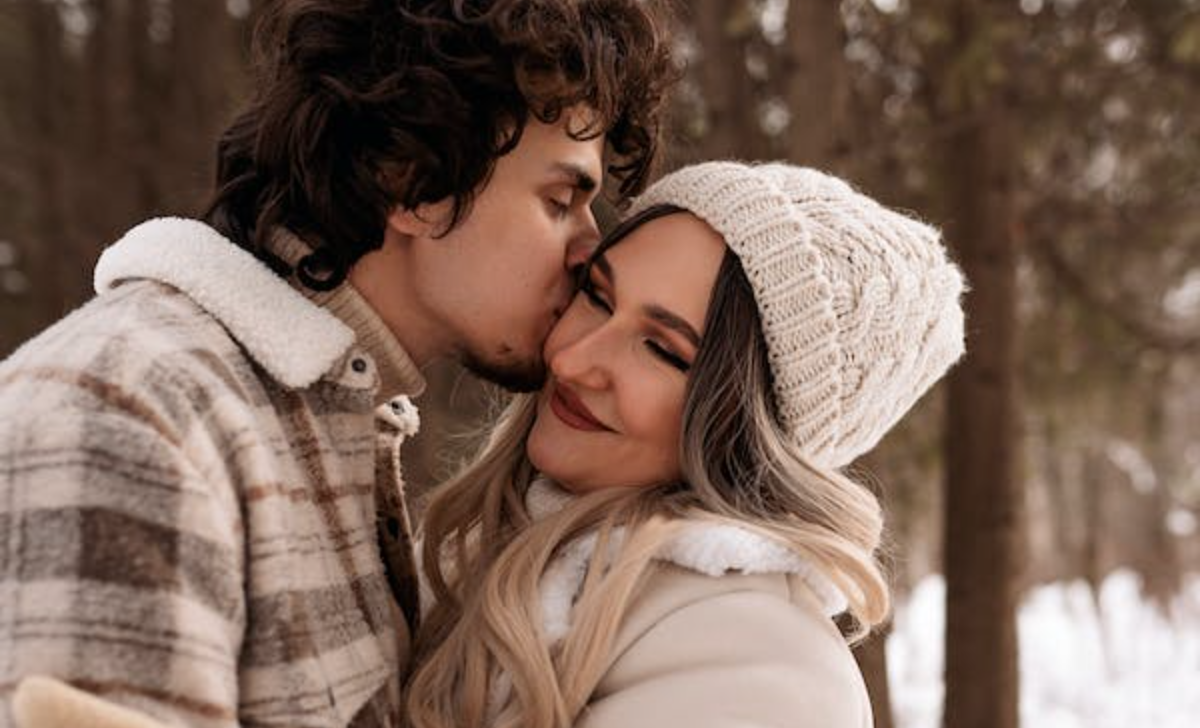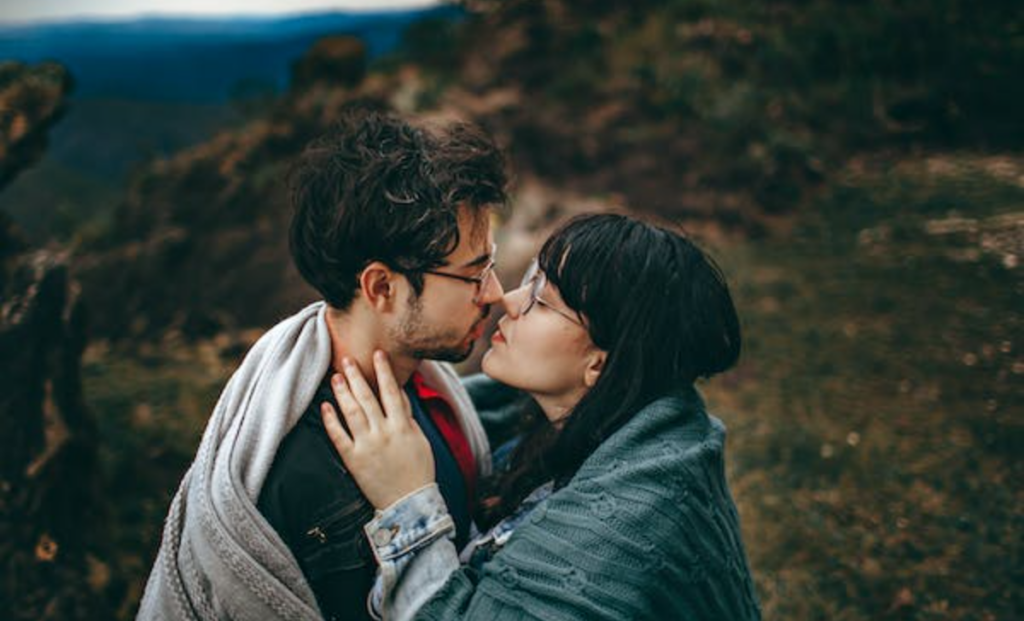Best friends share a unique and special bond. This connection often surpasses the boundaries of a typical friendship.
Exploring whether best friends kiss requires delving into the nature of these relationships. Best friends are companions who provide support, understanding, and companionship.
The question arises: Can this closeness evolve into physical intimacy, such as kissing? and Do best friends kiss?
Table of Contents
ToggleExploring the Reasons Why Best Friends Might Kiss

In the realm of platonic relationships, the notion of best friends sharing a kiss may raise eyebrows, but as we unravel the intricacies, we discover a myriad of reasons why this seemingly unconventional act might occur.
1. Spontaneity and Playfulness:
Sometimes, a kiss between best friends is simply an impromptu expression of joy and playfulness. In those carefree moments of shared laughter or celebration, a spontaneous kiss might emerge, devoid of romantic implications.
It becomes a lighthearted gesture, a playful reminder of the deep connection that underpins the friendship.
2. Emotional Intensity:
Best friendships often navigate emotional landscapes that rival those of romantic relationships. According to Psychology Today, a kiss is considered a form of intimacy in relationships, indicating the strength of relationship.
In moments of intense joy, sorrow, or profound connection, a kiss can serve as a non-verbal expression of the emotions that words may struggle to convey.
It becomes a way to share the depth of feelings without necessarily entering romantic territory.
3. Cultural Influences:
Cultural norms play a significant role in shaping the dynamics of friendships. In some cultures, friend-to-friend kisses are commonplace and symbolize camaraderie and closeness.
The act is not imbued with romantic connotations but rather reflects a cultural acceptance of physical affection between friends.
Understanding these cultural influences provides insight into why best friends might share a kiss.
4. Celebratory Moments:
Best friends often celebrate each other’s achievements and milestones. Whether it’s a graduation, a promotion, or a personal triumph, a kiss can be a spontaneous expression of shared joy and pride.
It becomes a symbol of mutual support and the joy derived from witnessing each other’s successes.
5. Comfort and Trust:
The foundation of any strong friendship is built on a bedrock of trust and comfort. In some instances, a kiss between best friends may arise from an unparalleled level of trust and ease with each other. It becomes a natural extension of the emotional intimacy and security they share, reinforcing the unbreakable bond between them.
6. Expressing Gratitude:
Gratitude is a powerful emotion within friendships, and a kiss can be a unique way to express it.
Whether it’s a thank you for unwavering support during tough times or a simple acknowledgment of the friend’s significance, a kiss becomes a heartfelt gesture of appreciation.
7. Testing Boundaries:
In some cases, friends might share a kiss as a way to test the waters or explore the boundaries of their relationship.
This exploration doesn’t necessarily imply a desire to transition into a romantic partnership but could be a way for friends to navigate the complexities of physical affection within the safety of a well-established friendship.
8. Alcohol and Social Influences:
Social settings and the influence of alcohol can sometimes blur the lines of friendships. In an atmosphere charged with celebration or perhaps under the influence, friends might share a kiss without fully considering the implications. It’s a reminder of how external factors can momentarily alter the dynamics of even the closest friendships.
9. Unspoken Connection:
Best friends often share an unspoken connection, an understanding that transcends words. A kiss, in such cases, becomes a silent language between friends, communicating sentiments that words fail to encapsulate. It’s a profound expression of the bond they’ve cultivated over time.
10. Evolution of Feelings:
Lastly, friendships are dynamic and can evolve. While this doesn’t imply a shift into romantic territory for everyone, some best friends might find their feelings deepening over time.
A kiss, in such instances, becomes a pivotal moment in acknowledging and navigating these changing dynamics.
In conclusion, the reasons why best friends might kiss are as diverse as the friendships themselves.
From spontaneity and cultural influences to emotional intensity and expressions of gratitude, each kiss is a unique facet of the intricate tapestry that defines these exceptional relationships.
Types of Kisses in Friendship

Kisses, often synonymous with romantic relationships, find a fascinating and diverse expression within the dynamic realm of friendships.
These various types of kisses contribute to the intricate language of platonic connections, each carrying its own unique meaning and adding depth to the emotional landscape of these cherished relationships.
1. The Cheek Kiss:
The cheek kiss, a classic and widely accepted form of platonic affection, involves a gentle peck on the cheek. This type of kiss serves as a friendly greeting or a symbol of camaraderie between friends. Its simplicity and warmth make it a versatile expression of fondness within the realm of friendships.
2. The Air Kiss:
The air kiss, often playful and theatrical, is characterized by bringing cheeks close without actual contact.
This light-hearted gesture is commonly observed in social settings and celebratory occasions among friends. It’s a symbolic display of affection that adds an element of joy and festivity to the friendship.
3. The Forehead Kiss:
The forehead kiss, a tender and intimate gesture, holds a special place in platonic connections. Given during moments of vulnerability or as a comforting reassurance, this type of kiss conveys a deep and nurturing bond between friends. It symbolizes care, support, and a profound level of trust.
4. The Celebratory Peck:
Reserved for moments of shared triumph and joy, the celebratory peck is a spontaneous expression of happiness between friends.
Whether celebrating academic achievements, professional success, or personal milestones, this kiss encapsulates the mutual pride and camaraderie within the friendship.
5. The Playful Lip Kiss:
In the spirit of light-hearted camaraderie, friends may engage in playful lip kisses. This type of kiss is not romantically charged but serves as a fun and affectionate expression of the bond between friends. Often accompanied by laughter, it highlights the joy and shared enjoyment within the friendship.
6. The Butterfly Kiss:
Delicate and whimsical, the butterfly kiss involves brushing eyelashes together. This unique form of connection is both intimate and innocent, symbolizing the subtlety and intricacy of the friendship. It reflects a gentle and close bond between friends.
7. The Eskimo Kiss:
Rooted in Inuit culture, the Eskimo kiss involves rubbing noses together. In friendships, this type of kiss signifies a close and familiar bond, reflecting the shared warmth and comfort between friends. It adds a touch of cultural richness to the language of platonic affection.
8. The Hand Kiss:
A refined and genteel gesture, the hand kiss entails pressing one’s lips to the back of a friend’s hand. This chivalrous display of admiration and respect is often seen in close-knit and sophisticated friendships. It reflects a sense of elegance and mutual esteem between friends.
9. The Peck on the Lips:
While traditionally associated with romantic relationships, a peck on the lips among friends can exist without romantic undertones.
This spontaneous expression of affection may occur between friends who share a deep and comfortable connection, emphasizing the platonic nature of the relationship.
10. The Blown Kiss:
A gesture that transcends physical proximity, the blown kiss involves sending a kiss through the air with a hand gesture.
In situations where physical contact is not possible, friends use this symbolic expression to convey affection. It adds a touch of whimsy and sweetness to the language of platonic connections.
When to kiss your bestfriend

Navigating the terrain of best friendships can be both rewarding and challenging. The question of when to introduce a kiss into the dynamic is a nuanced one, influenced by various factors that shape the unique connection between friends.
While there’s no one-size-fits-all answer, here are considerations that may guide you in deciding when to share a kiss with your best friend.
1. Emotional Intimacy:
Consider the level of emotional intimacy in your friendship. If you and your best friend share deep emotional bonds, where you confide in each other and provide unwavering support, introducing a kiss may be a natural progression to express the intensity of your connection.
2. Shared Moments of Joy:
Celebratory moments can create an atmosphere ripe for expressing affection. If you and your best friend find yourselves sharing moments of triumph, success, or pure joy, a celebratory kiss may be a spontaneous and joyful way to mark these special occasions.
3. Mutual Comfort Levels:
Understanding each other’s comfort levels is crucial. Before considering a kiss, ensure that both you and your best friend are on the same page regarding physical affection. Clear communication and mutual understanding of boundaries play a vital role in navigating this aspect of your relationship.
4. Testing Boundaries Gradually:
If you sense a potential shift in the dynamics of your friendship, consider testing boundaries gradually. Perhaps start with less intimate forms of physical affection, like hugs or cheek kisses, before exploring the possibility of a more significant gesture like a kiss.
5. Nonverbal Cues:
Pay attention to nonverbal cues and body language. If there’s a subtle exchange of glances, prolonged eye contact, or a genuine closeness that transcends the ordinary, these nonverbal cues may indicate a mutual desire for a more intimate connection.
6. Shared Cultural Understanding:
Cultural norms and values can significantly impact the acceptability and interpretation of physical affection between friends. If both you and your best friend come from cultures where friend-to-friend kisses are normalized, the introduction of a kiss might align more seamlessly with your shared understanding.
7. Trust and Open Communication:
Trust is the foundation of any lasting friendship. Before deciding to kiss your best friend, ensure that there is open communication about your feelings, intentions, and expectations. Trust and transparency pave the way for a healthy and consensual exploration of physical affection.
8. A Mutual Shift in Feelings:
If you both sense a shift in your feelings that goes beyond platonic friendship, discussing this shift openly is crucial. If the shift is mutual and both parties are comfortable exploring a more intimate dimension, a kiss may be a natural progression.
9. A Comfortable Setting:
Choose a setting where both you and your best friend feel relaxed and at ease. A comfortable and familiar environment can create the right atmosphere for an authentic and meaningful expression of affection.
10. Respecting Their Boundaries:
Above all, respect your best friend’s boundaries. If they express discomfort or hesitation, it’s essential to prioritize their feelings and maintain the friendship’s integrity. A kiss should enhance, not jeopardize, the connection you share.
In the realm of friendships, the decision to kiss your best friend is deeply personal. It requires careful consideration, open communication, and a shared understanding of the emotional landscape between you two.
Ultimately, timing is subjective, and what matters most is the mutual respect and genuine connection that define your friendship.
When Not to Kiss Your Best Friend

While the idea of kissing your best friend may cross your mind, there are situations and circumstances where it’s advisable to exercise caution or refrain from introducing this level of physical affection.
Here are scenarios in which it might be best to hold back on kissing your best friend:
1. Unspoken Discomfort:
If either you or your best friend has not openly discussed or expressed a desire for physical intimacy, it’s crucial to respect the unspoken boundaries.
Signs of discomfort or hesitation should be acknowledged and honored to maintain the comfort and trust within the friendship.
2. Unclear Mutual Feelings:
If there’s ambiguity or uncertainty about whether both parties share the same level of romantic or intimate feelings, introducing a kiss may complicate the friendship.
It’s essential to have open and honest conversations about emotions before considering such a significant step.
3. External Relationship Dynamics:
Consider external factors that may impact your friendship, such as current relationships or the potential for misunderstandings.
If either you or your best friend is in a committed relationship, introducing a kiss may be inappropriate and could lead to complications.
4. Under the Influence:
Avoid introducing physical affection, especially something as significant as a kiss, when either you or your best friend is under the influence of substances like alcohol or drugs.
Clear-headed communication and consent are crucial, and substances may cloud judgment.
5. Lack of Communication:
If there hasn’t been clear and open communication about feelings, intentions, or boundaries, it’s advisable to refrain from introducing physical affection.
Lack of communication can lead to misunderstandings, potentially jeopardizing the friendship.
6. One-sided Expectations:
If one party harbors romantic feelings that are not reciprocated by the other, introducing a kiss can lead to unbalanced expectations and potential emotional fallout.
It’s crucial to ensure both parties are on the same page to maintain the equilibrium of the friendship.
7. In Public or Uncomfortable Settings:
Choosing the right setting is key. Avoid introducing a kiss in public or unfamiliar places where either you or your best friend might feel uncomfortable or pressured. Opt for environments that allow for privacy and a sense of ease.
8. During Emotional Turmoil:
If either you or your best friend is going through emotional turmoil, such as a difficult breakup or personal challenges, introducing a kiss may not be the appropriate time. Emotional vulnerability can impact decision-making, and it’s essential to prioritize emotional well-being.
9. Cultural or Personal Taboos:
Respect cultural norms and individual beliefs. If friend-to-friend kissing is considered inappropriate or goes against personal values, it’s crucial to honor these perspectives. Understanding and acknowledging diverse cultural or personal taboos is fundamental in maintaining respect within the friendship.
10. Fear of Jeopardizing the Friendship:
If there’s a genuine concern that introducing a kiss might jeopardize the friendship or create tension, it’s advisable to weigh the potential consequences carefully. The preservation of the deep connection and trust within the friendship should take precedence.
In conclusion, it’s essential to exercise mindfulness and consider the intricacies of your friendship before deciding to introduce a kiss.
Open communication, mutual understanding, and a respect for boundaries are foundational to ensuring that any physical affection aligns with the comfort and desires of both parties.
Will kissing your best friend ruin your friendship?

The impact of kissing your best friend on the dynamics of your friendship can be a complex and subjective matter. While it doesn’t necessarily spell doom for all friendships, there are factors to consider that may influence the outcome.
1. Open Communication:
The foundation of any strong friendship is open communication. If you and your best friend can openly discuss your feelings, expectations, and concerns before and after the kiss, it may strengthen rather than weaken your friendship.
Honest dialogue allows both parties to understand each other’s perspectives and navigate potential changes in the relationship.
Read more: How To Tell an Older Woman You Want Her?
2. Mutual Consent:
Consent is crucial in any intimate interaction. If both you and your best friend mutually agree on exploring physical affection and have a shared understanding of the implications, the experience is more likely to be positive.
Respect for each other’s boundaries and clear consent contributes to a healthier exploration of romantic feelings within a friendship.
3. Understanding Expectations:
Consideration of each other’s expectations is vital. If the kiss is seen as a natural progression in the evolving dynamics of your friendship and both parties have realistic expectations, it can deepen your connection.
However, unmet or mismatched expectations may lead to misunderstandings and potential strains on the friendship.
4. Existing Relationship Status:
The relationship status of both parties is a significant factor. If either you or your best friend is already in a committed romantic relationship, introducing a kiss may complicate matters.
It’s important to be mindful of external factors and their potential impact on the friendship.
5. Emotional Preparedness:
Emotional preparedness is key to navigating the aftermath of a kiss. If either you or your best friend feels emotionally unprepared for the potential shift in dynamics, it could lead to discomfort or uncertainty. Taking the time to assess emotional readiness can contribute to a smoother transition.
6. Shared Understanding of Friendship:
Consider the foundational understanding of your friendship. If both you and your best friend have a solid foundation built on trust, mutual respect, and a deep connection, the friendship may withstand the introduction of physical affection.
Strong friendships often have a level of resilience that allows them to adapt to changes.
7. Respecting Boundaries:
Respect for each other’s boundaries post-kiss is critical. If either party feels uncomfortable or wishes to maintain the platonic nature of the friendship, it’s essential to honor those boundaries. Pressuring the other person or ignoring their feelings can strain the friendship.
8. Cultural and Personal Perspectives:
Respect for diverse cultural and personal perspectives is crucial. If friend-to-friend kissing aligns with both your and your best friend’s cultural norms and personal values, it may not have a detrimental impact. However, differences in cultural expectations should be navigated with sensitivity.
9. Reflection on Individual Feelings:
Reflection on individual feelings is necessary. If either you or your best friend realizes that the romantic feelings are not reciprocated or that the kiss has introduced unwelcome complexities, acknowledging these feelings is important. Honest self-reflection can guide decisions moving forward.
10. Potential for Change:
Recognize that introducing a kiss may bring about changes in the dynamics of your friendship.
Whether these changes are positive or challenging depends on the specific circumstances and the individuals involved.
Being aware of the potential for change allows for better preparation and adaptation.
So, while kissing your best friend doesn’t inherently ruin a friendship, the outcome depends on factors such as communication, consent, expectations, and emotional preparedness.
Open dialogue, mutual respect, and a shared understanding of the friendship contribute to the resilience of the relationship in the face of changes. It’s a nuanced journey that requires careful consideration and awareness of each other’s feelings and boundaries.
How to Approach Kissing Your Best Friend

Introducing a romantic element into a best friendship is a delicate matter that requires careful consideration and respect for both parties involved.
If you’re contemplating kissing your best friend, here are some steps to approach this situation with sensitivity and mindfulness:
1. Gauge the Mutual Connection:
Before considering a kiss, assess the mutual connection between you and your best friend. Look for signs of emotional intimacy, shared moments, and a deep bond.
A strong foundation can provide a context for a more intimate gesture.
2. Establish Open Communication:
Create an environment of open communication. Talk openly about feelings, emotions, and the dynamics of your friendship. Ensure that both you and your best friend feel comfortable discussing potentially sensitive topics.
3. Assess Their Comfort Levels:
Before introducing physical affection, gauge your best friend’s comfort levels with touch and intimacy. Pay attention to nonverbal cues and subtle signals that may indicate their readiness or hesitation.
4. Choose the Right Setting:
Setting matters. Opt for a comfortable and private environment where you and your best friend can engage in an open conversation without external distractions or potential awkwardness. The right setting can contribute to a relaxed atmosphere.
5. Test the Waters Gradually:
If you sense that a romantic shift might be welcomed, test the waters gradually. Start with subtle forms of physical affection, such as holding hands or hugging, before considering a kiss. This allows both parties to adjust to a changing dynamic.
6. Express Your Feelings:
Clearly express your feelings and intentions. Share with your best friend why you’re contemplating a kiss and what it means to you. Honesty and transparency lay the groundwork for a more genuine and understanding connection.
7. Read Their Body Language:
Pay attention to body language. Positive body language, such as leaning in or prolonged eye contact, may indicate receptivity to a more intimate gesture. Conversely, if your best friend exhibits signs of discomfort, it’s crucial to respect those boundaries.
8. Be Mindful of Consent:
Obtain clear consent before attempting a kiss. Consent is a fundamental aspect of any physical interaction, and both parties should feel comfortable and willing. A simple and direct question like “Can I kiss you?” ensures clarity.
9. Acknowledge Potential Outcomes:
Recognize that introducing a romantic element may lead to various outcomes. Be prepared for the possibility that feelings may not be reciprocated in the same way. Acknowledge the potential for changes in the dynamics of your friendship.
10. Respect Their Response:
Respect their response, whatever it may be. If your best friend expresses discomfort or indicates that they’d prefer to maintain a platonic relationship, honor their feelings. Pressuring or insisting can strain the friendship.
11. Be Prepared for Conversation:
After the kiss, be prepared for a follow-up conversation. Discuss the experience openly, allowing both of you to share your feelings and thoughts. This post-kiss conversation is crucial for understanding each other’s perspectives.
12. Navigate Changes with Sensitivity:
If the kiss leads to changes in your friendship, navigate these changes with sensitivity. Be attuned to your best friend’s feelings and give each other the space to process the evolving dynamics.
13. Reassess and Adapt:
Reassess the situation and adapt accordingly. If the kiss brings you closer, continue to nurture the evolving connection.
If it creates challenges, reassess the nature of your friendship and make decisions that prioritize the well-being of both parties.
Remember, introducing a romantic element into a best friendship is a decision that requires thoughtful consideration, open communication, and respect for each other’s feelings and boundaries.
Approach the situation with a genuine understanding of the potential impact on your friendship and be prepared for the various outcomes that may arise.
Read more: Why Do Girls Like Toxic Guys
Do Best Friends Kiss on the Lips?
Whether best friends kiss on the lips varies widely based on cultural, individual, and situational factors. Some best friends may share a kiss on the lips as an expression of deep platonic affection like biting your boyfriend , while others may reserve such intimacy for romantic relationships.
The acceptability of lip kisses between friends hinges on mutual consent, comfort levels, and the unique dynamics of each friendship.
It’s not a universal practice, and what may be appropriate for some friends might not be for others.
Is It Appropriate to Kiss Your Best Friend?
The appropriateness of kissing your best friend depends on the context, mutual feelings, and the nature of your friendship.
In some cases, a kiss may be a natural expression of affection, while in others, it might complicate the dynamics. It’s crucial to consider factors such as existing relationships, individual comfort levels, and the potential impact on the friendship.
Open communication is key; discussing feelings and expectations can help determine whether a kiss aligns with both parties’ comfort and boundaries.
Is It Normal for Girls to Kiss Their Best Friend?
The idea of girls kissing their best friends is subjective and culturally influenced. In certain cultures and friendships, it might be considered a normal and affectionate expression. However, societal norms and personal boundaries play a significant role.
What’s essential is understanding and respecting the comfort levels and expectations of all involved parties. It’s not about whether it’s “normal” but whether it aligns with the values and dynamics of the specific friendship.
What Does It Mean If You Kiss Your Best Friend?
The meaning behind kissing your best friend can vary based on the context and the individuals involved.
For some, a kiss may be a natural extension of deep platonic affection, symbolizing trust, intimacy, and a strong emotional connection.
It could also signal a shift in feelings, potentially indicating a desire for a more romantic relationship.
Communication is key in deciphering the meaning; discussing the implications of the kiss can help both parties understand each other’s perspectives and navigate potential changes in the dynamics of their friendship.
Discover more: Why Do Guys Melt When A Girl Cries
Conclusion: Do Best Friends Kiss
In conclusion, the question of whether best friends kiss delves into the intricate nuances of friendship dynamics, cultural influences, and individual comfort levels.
FAQ: About Best Friends Kissing
Can Friends Cuddle and Kiss?
Yes, friends can cuddle and kiss, but the appropriateness depends on the mutual consent and comfort levels of those involved. Clear communication about boundaries is essential to ensure both parties feel comfortable with physical affection within the friendship.
Does Kissing Your Best Friend Count as a First Kiss?
Yes, kissing your best friend qualifies as a first kiss, and the significance lies in the emotional connection shared. While it may not be a traditional romantic first kiss, it still holds meaning within the context of a close, platonic relationship.
Is Cuddling with Your Best Friend OK?
Cuddling with your best friend is okay if both parties are comfortable with the level of physical intimacy. Mutual consent, clear communication, and understanding of each other’s boundaries are crucial to ensure that cuddling remains within the comfort zones of the friendship.
Can You Cuddle with Your BFF?
Yes, cuddling with your Best Friend Forever (BFF) is permissible if both individuals are comfortable with the idea. It can enhance the bond between friends, but mutual understanding and respect for personal boundaries are essential to maintain the platonic nature of the relationship.
Can Best Friends Fall in Love?
Yes, best friends can develop romantic feelings for each other. The emotional intimacy and shared experiences in a close friendship can foster romantic connections. However, navigating this transition requires open communication, mutual consent, and an awareness of the potential impact on the dynamics of the friendship.
Can Friends Cuddle and Sleep Together?
Friends can cuddle and sleep together, but it depends on the comfort levels and mutual consent of those involved. Establishing clear boundaries and communicating openly about expectations is crucial to avoid any misunderstandings and maintain the platonic nature of the relationship.
Why Does My Best Friend Want to Cuddle?
Your best friend may want to cuddle for various reasons, such as seeking comfort, expressing affection, or enjoying a sense of closeness. Understanding their motivations through open communication can help clarify their intentions and ensure that both parties are on the same page.
Can Friends Give Hugs?
Yes, friends can give hugs, and it is a common and socially acceptable form of physical affection. Hugging is often seen as a friendly and warm gesture that expresses care, support, and camaraderie within the bounds of platonic friendship.


